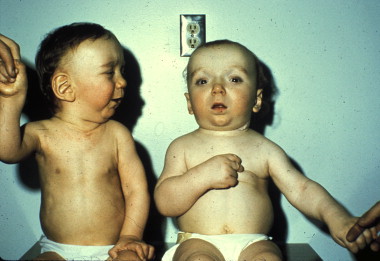Weaver Syndrome
Clinical Definition and Features
 Figure X-1 | Photo courtesy of Science Direct Opens in new window
Figure X-1 | Photo courtesy of Science Direct Opens in new window
Weaver syndrome is an autosomal-dominantly inherited overgrowth syndrome, of which affected infants are long at birth and experience accelerated growth rates with advanced bone age. Joint contractures, especially camptodactyly, are common. Cognitive development may be delayed.
In 1974, Weaver et al reported a syndrome of persistent overgrowth of which infants have a normal birth weight but excessive length.
- Rate of growth is accelerated in the first few months of life and bone age is advanced.
- The forehead is broad and the ears are fleshy.
- The hands show contractural arachnodactyly and mobility of the elbows, hips, and knees is decreased.
These children are heavy boned. There are no overt birth defects and general health is good, whereas cognitive development is usually delayed.
Although reported cases have been sporadic, several families have been reported in which the findings in the affected parent were much less striking than in the affected child.
The phenotype becomes less striking as affected individuals enter adulthood. Ultimate adult height is excessive, however when compared with family members of normal stature.
These clinical features and other findings are elaborated under the following headings.
- Growth and Skeletal Findings
- Mean birth weight is 4785 g in males and 3883 g in females.
- Birth length is 56 cm in males and 53 cm in females.
- Head circumference at birth is 36.6 cm in males and 35.2 cm in females.
- Adult head circumference is 61 cm in males and 59.5 cm in females.
- Final height attainment is 194.2 cm in males and 176.3 cm in females.
- Adult weight is 102.2 kg in males and 87.6 kg in females.
- Performance and Central Nervous System
Mild hypertonia (75%) or hypotonia is common, and motor development is mildly to moderately retarded. The cry is low-pitched and hoarse (100%).
Although the appetite is voracious, hypothalamic dysregulation has not been demonstrated. Difficulty in swallowing or breathing has been noted in several cases.
Other findings have included cysts of the septum pelucidum, pachygyria, dilation of the ventricles, basal cisterns, sylvian cistern, and interhemispheric fissure, consistent with nonspecific cerebral atrophy, and enlarged vessels and hypervascularization in the areas of the middle and left posterior cerebral arteries.
- Craniofacial Features
Macrocephaly Opens in new window (90%), broad forehead (100%), and flattened occiput are characteristic. Scalp hair is moderately thin. The ears are large (95%) and may be mildly dysmorphic or low-set.
Other features include hypertelorism, long prominent philtrum (90%), depressed nasal bridge (80%), relative micrognathia, and redundant nuchal skin folds.
Low-frequency findings have been reported such as mild craniofacial asymmetry, upslanting or downslanting palpebral fissures, small palpebral fissures, ptosis, strabismus, and highly arched palate.
- Limbs
Common findings include camptodactyly (65%), prominent finger pads, thin deeply set nails, broad thumbs, clinodactyly of toes, and limited extension at elbows and knees.
Foot deformities have been observed such as talipes equinovarus, talipes calcaneovalgus, metatarsus adductus, pes adductus, and apes cavus.
Deep creases may be observed on the palmar and plantar surfaces. Bone age is remarkably advanced; the growth parameters of head circumference, length, and weight are two-to-three times the expected rate.
Carpal maturation is accelerated over that of phalanges and metacarpals. Other skeletal findings include abnormal cervical vertebrae, widened or splayed long bone metaphyses, especially of the femurs, and somewhat mottled epiphyses. The iliac wings may be broad and low.
Diagnosis
The diagnosis is usually apparent by physical examination, but studies help confirm it. Bone age is advanced but not beyond the height age. Growth hormone and 17 hydroxy-progesterone levels are normal.
The karyotype is normal. Films often show hypoplasia of one or more cervical vertebral bodies that may contribute to instability of the cervical spine. Among the less than 25 reported cases in the literature, three patients had embryonal tumors of different types.
Differential Diagnosis
Weaver syndrome should be differentiated from Sotos syndrome Opens in new window, with which it is sometimes confused.
There are Weaver-like syndromes, some of which include acromegaly Opens in new window; Marshall syndrome; Congenital adrenal hyperplasia (21 hydroxylase deficiency).
Therapeutics
Treatment is supportive and symptomatic. The cervical spine may need to be stabilized.
Physical therapy may help increase range of motion of the major joints. Affected adults have good general health without significant physical limitations.
The prognosis for an affected child seems largely dependent on cognitive development, which should be closely monitored.
See also:
- Weaver DD, Graham CB, Thomas IT, et al. A new overgrowth syndrome with accelerated skeletal maturation, unusual facies, and camptodactyly. J Pediatr 1974;84:547-552.
- Derry C, Temple IK, Venkat-Raman K. A probable case of familial Weaver syndrome associated with neoplasia. J Med Genet 1999;36:725-728.
- Fryer A, Smith C, Rosenbloom L, et al. Autosomal dominant inheritance of Weaver syndrome. Am J Med Genet 1997;34:418-419.
- Greenberg F, Wasiewski W, McCabe ERB. Weaver syndrome: the changing phenotype in an adult. J Med Genet 1989;33:127-129.
- Majewski F et al: The Weaver syndrome: A rare type of primordial overgrowth. Eur J Pediatr 137:277-282, 1981.
- Marshall RE et al: Syndrome of accelerated skeletal maturation and relative failure to thrive: A newly recognized clinical growth disorder. J Pediatr 78:95-101, 1971.
- Meinecke P et al: The Weaver syndrome in a girl. Eur J Pediatr 141:58-59, 1983.
- Muhonen MG, Menezes AH: Weaver syndrome and instability of the upper cervical spine. J Pediatr 116:596-599, 1990.
- Opitz JM et al: The syndrome of Sotos and Weaver: Reports and review. Am J Med Genet 79: 294-304, 1998.

